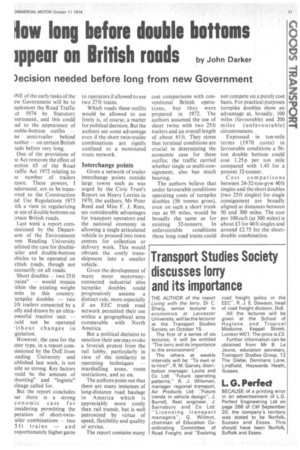low long before double bottoms
Page 23

If you've noticed an error in this article please click here to report it so we can fix it.
*pear on British roads by John Darker
)ecision needed before long from new Government
1NE of the early tasks of the ew Government will be to nplement the Road Traffic .ct 1974 by Statutory lstrument, and this could ad to the appearance of ouble-bottom outfits — tie semi-trailer behind nother — on certain British )ads before very long, One of the provisions of ie Act removes the effect of ection 65 of the Road raffic Act 1972 relating to ie number of trailers rawn. These powers. 1 nderstand, are to be transTred to the Construction nd Use Regulations 1973 rith a view to regularizing ie use of double bottoms on ..rtain British roads.
Last week a report corniissioned by the Departlent of the Environment .om Reading University utlined the case for doubleailer and double-bottom ..hicles to be operated on ritish Koa4s, though not ecessarily on all roads.
Short doubles two 25 ft :rains" -would remain ithin the existing weight mits in this country. urnpike doubles — two El ft trailers connected by a olly and drawn by an ultraowerful tractive unit -Duld not be operated 'ithout changes in However, the case for the Ltter type, in a report corniissioned by the DoE from .eading University and ublished last week, is not uite so strong. Key factors ould be the amount of ;hunting" and "logistic" iileage called for.
But the report concludes iat there is a strong conornic case for 3nsidering permitting the peration of short-twin.ailer combinations — two 5 ft trains — and roportionately higher gains to operators if allowed to use two 27ft trains.
Which roads these outfits would be allowed to use freely is, of course, a matter for political decision. But the authors see some advantage even if the short twin-trailer combinations are rigidly confined to a nominated route network.
Interchange points
Given a network of trailer interchange points outside large towns such as was urged by the Civic Trust's Report on Heavy Lorries in 1970, the authors, Mr Peter Reed and Miss F. J. Rees, see considerable advantages for transport operators and the national economy in allowing a single articulated vehicle to proceed into town centres for collection or delivery work. This would obviate the costly transshipment into a smaller vehicle.
Given the development of many more motorwayconnected industrial sites turnpike doubles could progressively assume a distinct role, more especially if an EEC trunk road network permitted their use within a geographical area comparable with North America.
But a political decision to sanction their use may evoke a feverish protest from the rail lobby, particularly in view of the similarity in operating techniques — marshalling areas, route restrictions, and so on.
The authors point out that there are many instances of long-distance road haulage in America which is appreciably more costly than rail transit, but is well patronized by virtue of speed, flexibility and quality of service.
The report contains many cost comparisons with conventional British operations, but they were prepared in 1972. The authors assumed the use of short twins with two 25 ft trailers and an overall length of about 61 ft. They stress that terminal conditions are crucial in determining the economic case for these outfits; the traffic carried whether single or multi-consignment, also has much bearing.
The authors believe that under favourable conditions operating costs of turnpike doubles (56 tonnes gross), even on such a short trunk run as 95 miles, would be broadly the same as for existing 32-tonners. In unfavourable conditions these long road trains could not compete on a purely cost basis. For practical purposes turnpike doubles show an advantage at, broadly, 100 miles (favourable) and 200 miles (unfavourable) circumstances.
Expressed in ton-mile terms (1970 costs) in favourable conditions a 56ton double bottom could cost 1.25 p per ton mile compared with 1.43 for a present 32-tonner.
Cost comparisons between 24-32-ton-gvw 40 ft singles and the short doubles (two 25 ft singles) for single consignment are broadly aligned at distances between 50 and 300 miles. The cost per 100 cu ft (at 300 miles) is about £3 for 40ft singles and around £2.75 for the shortdouble combination.




























































































































































